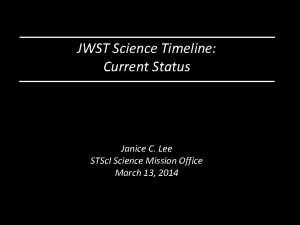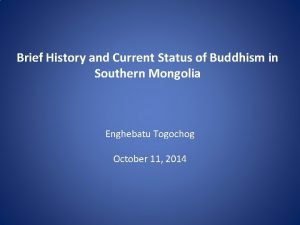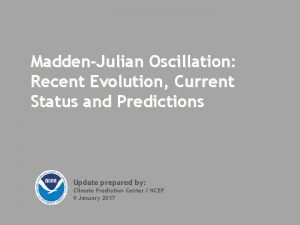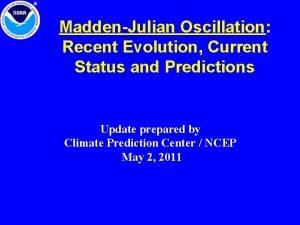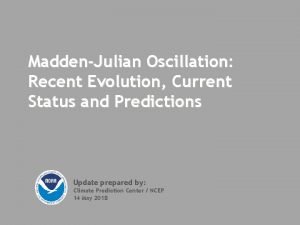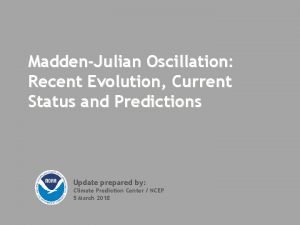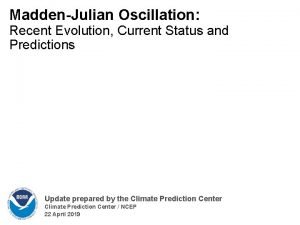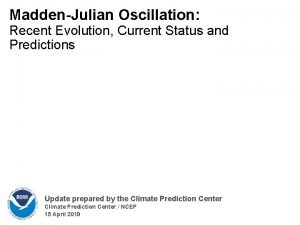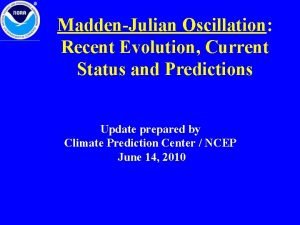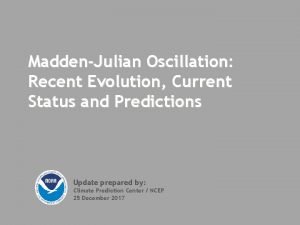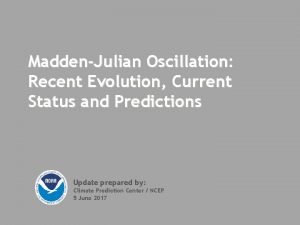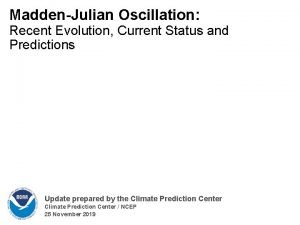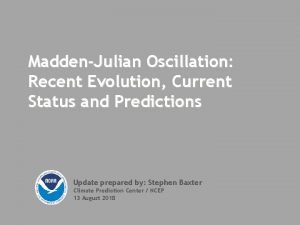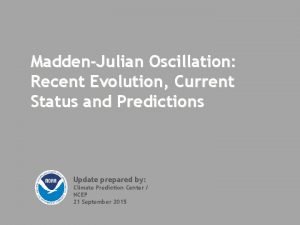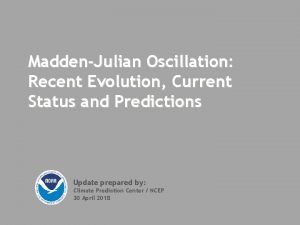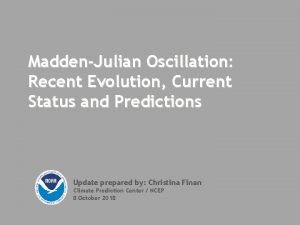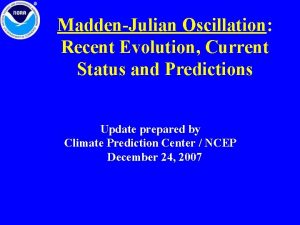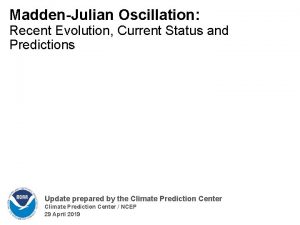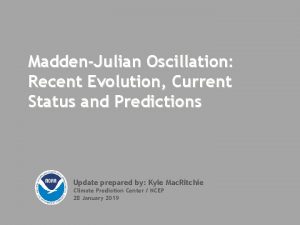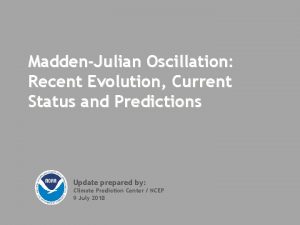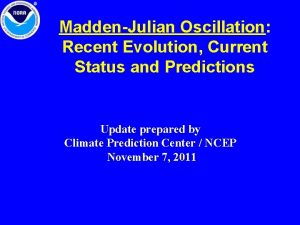MaddenJulian Oscillation Recent Evolution Current Status and Predictions





















- Slides: 21

Madden-Julian Oscillation: Recent Evolution, Current Status and Predictions Update prepared by Climate Prediction Center / NCEP April 04, 2011

Outline • Overview • Recent Evolution and Current Conditions • MJO Index Information • MJO Index Forecasts • MJO Composites

Overview • The MJO signal has strengthened during the last seven days. • The majority of dynamical model MJO index forecasts indicate continued eastward propagation over the next two weeks. • This signal favors enhanced rainfall for parts of the Maritime continent, northern Australia, the western Pacific and the South Pacific Convergence Zone during Week-1. Drier-than-average conditions are favored across the Indian Ocean during both Weeks 1 and 2. Additional potential impacts across the global tropics are available at: http: //www. cpc. ncep. noaa. gov/products/precip/CWlink/ghazards/index. php

850 -h. Pa Vector Wind Anomalies (m s-1) Note that shading denotes the zonal wind anomaly Blue shades: Easterly anomalies Red shades: Westerly anomalies strengthened and expanded eastward across the Maritime Continent during the last five days. Easterly anomalies strengthened across the western Pacific during the last five days.

850 -h. Pa Zonal Wind Anomalies (m s-1) Westerly anomalies (orange/red shading) represent anomalous west-to-east flow Easterly anomalies (blue shading) represent anomalous east-to-west flow Easterly anomalies have persisted in the west-central Pacific since October (black box) consistent with La Nina conditions. The MJO strengthened in October as evidenced by weak westerly anomalies and a weakening of the easterlies across the central Pacific during mid-October. (blue box). Time In late January, easterly winds weakened and westerly anomalies developed near the Date Line due to MJO activity. During March, easterlies strengthened near the Date Line, while westerly wind anomalies increased dramatically in strength at the end of the month. Longitude

OLR Anomalies – Past 30 days Drier-than-normal conditions, positive OLR anomalies (yellow/red shading) Wetter-than-normal conditions, negative OLR anomalies (blue shading) During early March, enhanced convection (blue circle) continued over northern South America, close to Hawaii , and from Australia to the Philippines. Suppressed convection (red circle) also continued across the southern Indian Ocean. During mid-March, enhanced convection continued over the Maritime Continent, Australia and parts of Southeast Asia with suppressed convection observed across the southern tier of the U. S. . During late March, enhanced convection continued across Australia, the Maritime continent and the Philippines. Convection relaxed across and northern South America while suppressed convection continued across the southern tier of the U. S. .

Outgoing Longwave Radiation (OLR) Anomalies (7. 5°S-7. 5°N) Drier-than-normal conditions, positive OLR anomalies (yellow/red shading) Wetter-than-normal conditions, negative OLR anomalies (blue shading) (Courtesy of the Bureau of Meteorology (BOM) Australia) MJO activity was experienced during late November into December and once again during January. During both periods, enhanced convection developed near 80 E and shifted to the Maritime continent followed by an area of suppressed convection. Time Enhanced convection was evident across northern South America during much of February and March but shifted eastward during the last several days. During late March, a large area of strongly enhanced convection developed between 80 E to 140 E. Longitude

200 -h. Pa Velocity Potential Anomalies (5°S-5°N) Positive anomalies (brown shading) indicate unfavorable conditions for precipitation Negative anomalies (green shading) indicate favorable conditions for precipitation The MJO strengthened during late September as anomalies increased and eastward propagation was seen through mid-October. Time During late November and early December, some eastward propagation associated with the MJO is evident in velocity potential anomalies. During mid-to-late January, the MJO strengthened and upper-level divergence shifted eastward from 120 E and upper-level convergence shifted from Africa to near the Date Line. Eastward propagation of anomalies was observed during March. Longitude

IR Temperatures (K) / 200 -h. Pa Velocity Potential Anomalies Positive anomalies (brown contours) indicate unfavorable conditions for precipitation Negative anomalies (green contours) indicate favorable conditions for precipitation The large scale velocity potential pattern shows anomalous upper-level divergence over the Maritime Continent, parts of the western Pacific Ocean, and intra-American seas region. Anomalous upper-level convergence strengthened during the past week and shifted eastward, spreading across Africa and into the Indian Ocean.

200 -h. Pa Vector Wind Anomalies (m s-1) Note that shading denotes the zonal wind anomaly Blue shades: Easterly anomalies Red shades: Westerly anomalies remained across the equatorial central Pacific during the last five to ten days (blue boxes).

200 -h. Pa Zonal Wind Anomalies (m s-1) Westerly anomalies (orange/red shading) represent anomalous west-toeast flow Easterly anomalies (blue shading) represent anomalous east-to-west flow Westerly anomalies persisted across a large area from the Maritime Continent to the central Pacific (black solid box) since October. Time In early October, westerly anomalies strengthened considerably associated with MJO activity and an eastward extension of these anomalies is evident. There was a gradual eastward shift in the core of the westerly anomalies across the Pacific during December and January (dashed line). Longitude In February, westerly anomalies shifted back to the west across the central Pacific similar to where they were during much of the September to December period. Some strengthening and eastward propagation of these westerly anomalies is evident in the most recent observations.

Weekly Heat Content Evolution in the Equatorial Pacific During April 2010 heat content anomalies decreased across the Pacific in association with the upwelling phase of a Kelvin wave and later during the early summer due to the development of La Nina. Time Since the beginning of January 2011, positive heat content anomalies have shifted eastward, while negative heat content anomalies weakened and then became positive across much of the Pacific basin. Longitude

MJO Index -- Information • The MJO index illustrated on the next several slides is the CPC version of the Wheeler and Hendon index (2004, hereafter WH 2004). Wheeler M. and H. Hendon, 2004: An All-Season Real-Time Multivariate MJO Index: Development of an Index for Monitoring and Prediction, Monthly Weather Review, 132, 1917 -1932. • The methodology is very similar to that described in WH 2004 but does not include the linear removal of ENSO variability associated with a sea surface temperature index. The methodology is consistent with that outlined by the U. S. CLIVAR MJO Working Group. Gottschalck et al. 2010: A Framework for Assessing Operational Madden-Julian Oscillation Forecasts: A CLIVAR MJO Working Group Project, Bull. Amer. Met. Soc. , 91, 1247 -1258. • The index is based on a combined Empirical Orthogonal Function (EOF) analysis using fields of near-equatorially-averaged 850 -h. Pa and 200 -h. Pa zonal wind and outgoing longwave radiation (OLR).

MJO Index -- Recent Evolution § The axes (RMM 1 and RMM 2) represent daily values of the principal components from the two leading modes § The triangular areas indicate the location of the enhanced phase of the MJO § Counter-clockwise motion is indicative of eastward propagation. Large dot most recent observation. § Distance from the origin is proportional to MJO strength § Line colors distinguish different months The MJO index has strengthened considerably with eastward propagation during the past seven days.

MJO Index – Historical Daily Time Series Time series of daily MJO index amplitude from 1995 to present. Plots put current MJO activity in historical context.

Ensemble GFS (GEFS) MJO Forecast Yellow Lines – 20 Individual Members Green Line – Ensemble Mean RMM 1 and RMM 2 values for the most recent 40 days and forecasts from the ensemble Global Forecast System (GEFS) for the next 15 days light gray shading: 90% of forecasts dark gray shading: 50% of forecasts The ensemble GFS forecasts a continued eastward propagating signal during the next two weeks towards the western Hemisphere.

Ensemble Mean GFS MJO Forecast Figures below show MJO associated OLR anomalies only (reconstructed from RMM 1 and RMM 2) and do not include contributions from other modes (i. e. , ENSO, monsoons) Spatial map of OLR anomalies for the next 15 days The GEFS ensemble mean forecast indicates suppressed convection shifting eastward across the Indian Ocean during Week-1 to the Maritime continent by Week-2. Time-longitude section of (7. 5°S-7. 5°N) OLR anomalies for the last 180 days and for the next 15 days

Statistical MJO Forecast Figure below shows MJO associated OLR anomalies only (reconstructed from RMM 1 and RMM 2) and do not include contributions from other modes (i. e. , ENSO, monsoons) Spatial map of OLR anomalies and 850 -h. Pa vectors for the next 20 days (Courtesy of the Bureau of Meteorology Research Centre - Australia) The forecast is for MJO activity during the period.

MJO Composites – Global Tropics Precipitation Anomalies (Nov-Mar) 850 -h. Pa Wind Anomalies (Nov-Mar)

U. S. MJO Composites – Temperature § Left hand side plots show temperature anomalies by MJO phase for MJO events that have occurred over the three month period in the historical record. Blue (orange) shades show negative (positive) anomalies respectively. § Right hand side plots show a measure of significance for the left hand side anomalies. Dark blue and purple shades indicate areas in which the anomalies are significant at the 95% or better confidence level. Zhou et al. (2010): A composite study of the MJO influence on the surface air temperature and precipitation over the Continental United States, Climate Dynamics, Submitted. http: //www. cpc. ncep. noaa. gov/products/precip/CWlink/MJO/mjo. shtml

U. S. MJO Composites – Precipitation § Left hand side plots show precipitation anomalies by MJO phase for MJO events that have occurred over the three month period in the historical record. Brown (green) shades show negative (positive) anomalies respectively. § Right hand side plots show a measure of significance for the left hand side anomalies. Dark blue and purple shades indicate areas in which the anomalies are significant at the 95% or better confidence level. Zhou et al. (2010): A composite study of the MJO influence on the surface air temperature and precipitation over the Continental United States, Climate Dynamics, Submitted. http: //www. cpc. ncep. noaa. gov/products/precip/CWlink/MJO/mjo. shtml
 Y connected generator
Y connected generator Line vs phase voltage
Line vs phase voltage Drift current and diffusion current
Drift current and diffusion current Lesson 4 three-phase motors
Lesson 4 three-phase motors Drift current and diffusion current in semiconductor
Drift current and diffusion current in semiconductor Drift current and diffusion current in semiconductor
Drift current and diffusion current in semiconductor Balanced y-y connection
Balanced y-y connection Infineon
Infineon Drift current and diffusion current in semiconductor
Drift current and diffusion current in semiconductor Size separation is also known as
Size separation is also known as The constant current region of a fet lies between
The constant current region of a fet lies between Chapter 3 shielded metal arc welding
Chapter 3 shielded metal arc welding Hazard based safety engineering
Hazard based safety engineering Kcl mesh analysis
Kcl mesh analysis Cpsr register diagram
Cpsr register diagram Jwst commissioning timeline
Jwst commissioning timeline Current status of buddhism
Current status of buddhism Periodic motion definition
Periodic motion definition Indication and contraindication of mobilization
Indication and contraindication of mobilization Peripheral joint mobilization
Peripheral joint mobilization Dynamics
Dynamics Graded oscillation techniques
Graded oscillation techniques















